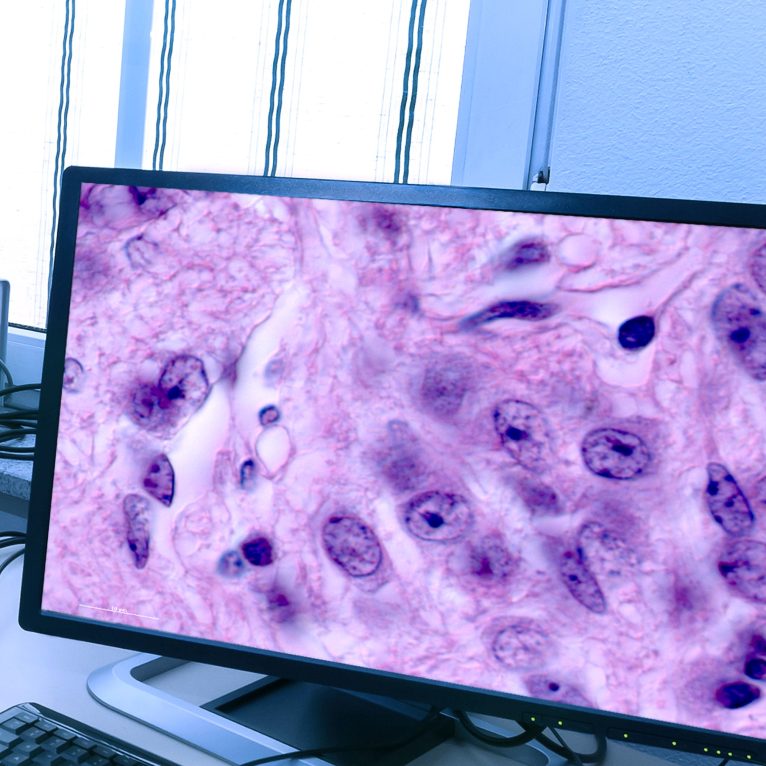
Written by

Cranfield, UK, 30th November 2023, Written by Imogen Fitt –
Happy holidays LinkedIn community! I hope my US colleagues had a great thanksgiving, again I’ve collected some of the digital pathology news stories that caught my attention this November:
- Google Health held a workshop during Pathology Visions 2023 which offered insights into the technology giant’s approach to #digitalpathology. A bullish attitude towards DICOM and plans to tackle the storage element of digitisation were just some of the key takeaways. Thanks to Alexander Sicularfor taking the time to present! DICOM is gaining increasing traction as a standard for digital pathology. As labs start to mature and scale their usage of digital workflows, image life cycle management will become an increasing problem unless we take a proactive approach today.
- Speaking of Pathology Visions 2023, my insight regarding the Digital Pathology Association‘s annual conference is now live… Take a peek to see some of Signify Research Ltd‘s key takeaways.
- A study was published recently describing the process followed to build the AI FORGE (Facilitating Opportunities for Robust Generalisable data Emulation) facility. It was built by the National Pathology Imagine Cooperative (NPIC) in the UK as a multi-scanner environment to both compare scanner performance across different types of scanners from 9 vendors (so far), and to create large image datasets with images to compare across systems. I’ve mentioned prior that generalisability in AI is a challenge for vendors, and acquiring large enough datasets to overcome this is something that can make or break a business. These datasets, if curated well, could offer a great contribution towards research and clinical progress.
- Alimentiv, AcelaBio, and PharmaNest have announceda collaborative effort to establish an integrated ecosystem to enhance nonalcoholic steatohepatitis (NASH now MASH) clinical trials using state-of-the-art spatial transcriptomics and AI enabled digital pathology. MASH is a popular area for digital pathology research today, with a large number of projects ongoing in this field. Partnerships like this hopefully indicate we’ll see some real progress in this condition soon.
- Apollo Enterprise Imaging Corp previewed a new version of its multidisciplinary medical imaging platform at #RSNA2023. Features which caught my eye for this update included an expansion of digital pathology WSI viewable formats and an increased speed to image display. Digital pathology has an ever-increasing presence at Radiology’s biggest annual event and and this wasn’t the only announcement that piqued my interest (see #9 and #10 below).
- PathAI released an update declaring AISight’s support of the DICOM standard. During the release the company also committed itself to becoming a leader in ‘integrated enterprise image architecture’. PathAI is expected to launch a DICOMweb API in its next release, which will enable AISight to receive DICOM images from external applications, push images back to Vendor Neutral Archives (VNAs), utilise the DICOM file to supplement or validate image/case data, and enable prefetch to pull historical cases/studies directly from image archives. VNAs are increasingly being positioned as a way to efficiently leverage existing radiology infastructure in hospitals to store whole slide images. Amy Thompson (our resident enterprise imaging expert) and I will actually be participating in a discussion next week at the Digital Pathology & AI Congress. We’ll be discussing the topic of VNAs in digital pathology with Dell Technologies.
- Next is another study, this time titled ‘operational greenhouse-gas emissions of deep learning in digital pathology’. It examined how the widespread use of deep learning in pathology would impact global-warming. Sustainability and green initiatives are having an increasing impact on digital pathology tenders as healthcare is having to justify new investments. Whilst the long-term impact of technologies needs to be carefully weighed, a fine balance between cost, environment and quality of care will need to be established.
- #GenerativeAI is certainly making a buzz across healthcare at the moment, and pathology is no different. This articledescribes the different use cases of foundation models and generative AI across pathology, offering insight into how we can help standardisation, education, and training.
- My next two new pieces relate to partnerships between radiology and pathology vendors. With #RSNA23 being held this week Indica Labs announced a partnership with Merge by Merativewhich indicates the enterprise imaging vendor is now able to resell HALO Clinical Solutions with its Enterprise Imaging and PACS solutions.
- Paige and Nuance Communications have also announced a collaboration to establish the ‘largest consultation network in pathology’ via merging Paige’s products like FullFocus® and FullFolio™, with PowerShare, Nuance’s image sharing network. PowerShare currently connects over 14,000 sites and the establishment of such a network should help broaden Paige’s prospective customer base.
As we near the holidays this will be my last update until January. I’m sure we’ll see some new announcements over the next few weeks so be sure to connect with me directly as I share the news in real time!
Did you find this roundup useful?
If you want to take a deeper dive into any of these announcements to discuss more detailed implications for the industry do drop me a note.
I’ll set up some time to learn more about how our market intelligence reports, content marketing services and decision maker researchcan help support your business.
About Imogen Fitt
Imogen joined Signify in 2018 as part of the Healthcare IT team. She holds a 1st class Biomedical Sciences degree from the University of Warwick where her studies included molecular biology and pharmacology. Since joining the team Imogen has studied the medical imaging software and hardware markets and is now expanding Signify Research’s Diagnostics and Lifesciences coverage.
About the Diagnostics and Lifesciences Team
The Diagnostics and Lifesciences team provides market intelligence and detailed insights on the multiple healthcare technology markets where the clinical world intersects with the preclinical. Our areas of coverage include digital pathology, laboratory information systems, clinical Real-World Data (cRWD) platforms, oncology information systems, tumour board software, oncology decision support software and radiotherapy IT. Each report provides a data-centric and global outlook of its markets with granular country-level insights. Our research process blends primary data collected from in-depth interviews with healthcare professionals and technology vendors, to provide a balanced and objective view of the market.
About Signify Research
Signify Research provides healthtech market intelligence powered by data that you can trust. We blend insights collected from in-depth interviews with technology vendors and healthcare professionals with sales data reported to us by leading vendors to provide a complete and balanced view of the market trends. Our coverage areas are Medical Imaging, Clinical Care, Digital Health, Diagnostic and Lifesciences and Healthcare IT.
Clients worldwide rely on direct access to our expert Analysts for their opinions on the latest market trends and developments. Our market analysis reports and subscriptions provide data-driven insights which business leaders use to guide strategic decisions. We also offer custom research services for clients who need information that can’t be obtained from our off-the-shelf research products or who require market intelligence tailored to their specific needs.
More Information
To find out more:
E: enquiries@signifyresearch.net
T: +44 (0) 1234 986111
www.signifyresearch.net
